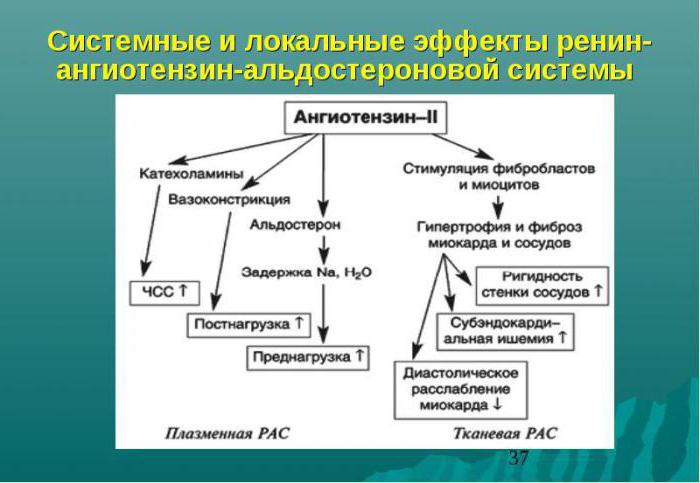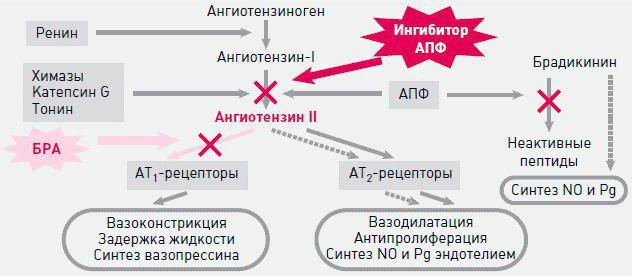The renin-angiotensin-aldosterone system is a complex of enzymes and hormones that support homeostasis. Regulates the balance of salt and water in the body and the level of blood pressure.
Work mechanism
The physiology of the renin-angiotensin-aldosterone system originates at the border of the cortex and medulla of the kidney, where there are juxtaglomerular cells that produce peptidase (an enzyme) - renin.
Renin is the hormone and primary link of RAAS.
Situations in which renin is secreted into the blood
There are several conditions in which the hormone enters the bloodstream:
- Reduction of blood flow in the kidney tissue - with inflammatory processes (glomerulonephritis, etc.), with diabetic nephropathy, kidney tumors.
- Decreased circulating blood volume (with bleeding, repeated vomiting, diarrhea, burns).
- Drop in blood pressure. There are baroreceptors in the arteries of the kidneys that respond to changes in systemic pressure.
- Change in the concentration of sodium ions. In the human body there are clusters of cells that respond to changes in the ionic composition of the blood by stimulating the production of renin. Salt is lost with excessive sweating, as well as with vomiting.
- Stress, psycho-emotional stress. The juxtaglomerular apparatus of the kidney is innervated by the sympathetic nerves, which are activated by negative psychological influences.
In the blood, renin is found with a protein called angiotensinogen, which is produced by liver cells and takes a fragment from it. Angiotensin I is formed, which is the source of exposure for the angiotensin converting enzyme (ACE). The result is angiotensin II, which serves as the second link and is a powerful vasoconstrictor of the arterial system (constricts blood vessels).
The effects of angiotensin II
Goal: increase blood pressure.
- Promotes the synthesis of aldosterone in the glomerular zone of the adrenal cortex.
- It affects the center of hunger and thirst in the brain, causing a "salt" appetite. Human behavior becomes motivated by the search for water and salty foods.
- It affects the sympathetic nerves, contributing to the release of norepinephrine, which is also a vasoconstrictor, but less weak in action.
- It acts on the vessels, causing their spasm.
- Participates in the development of chronic heart failure: promotes proliferation, vascular and myocardial fibrosis.
- Reduces glomerular filtration rate.
- It inhibits the production of bradykinin.

Aldosterone is the third component that acts on the terminal tubules of the kidneys and promotes the release of potassium, magnesium ions from the body and the reverse absorption (reabsorption) of sodium, chlorine, and water. Due to this, the volume of circulating fluid increases, blood pressure figures rise, and renal blood flow increases. Aldosterone receptors are found not only in the kidneys, but also in the heart and blood vessels.
When the body reaches homeostasis, vasodilators (substances that dilate blood vessels) begin to be produced - bradykinin and kallidin. And the components of RAAS are destroyed in the liver.
Scheme of the renin-angiotensin-aldosterone system
Like any system, RAAS can fail. The pathophysiology of the renin-angiotensin-aldosterone system is manifested in the following conditions:
- Damage to the adrenal cortex (infection, hemorrhage and trauma). Aldosterone deficiency develops, and the body begins to lose sodium, chlorine and water, which leads to a decrease in the volume of circulating fluid and a decrease in blood pressure. The condition is compensated by the introduction of saline solutions and stimulators of receptors for aldosterone.
- A tumor of the adrenal cortex leads to an excess of aldosterone, which realizes its effects and increases pressure. Cell division processes are also activated, hypertrophy and myocardial fibrosis occur, and heart failure develops.
- Liver pathology, when the destruction of aldosterone is impaired and its accumulation occurs. Pathology is treated with aldosterone receptor blockers.
- Renal artery stenosis.
- Inflammatory kidney disease.
The significance of RAAS for life and medicine
Renin-angiotensin-aldosterone system and its role in the body:
- takes an active part in maintaining a normal blood pressure indicator;
- provides balance of water and salts in the body;
- maintains an acid-base blood balance.
The system may crash. By acting on its components, it is possible to fight hypertension. The mechanism of renal hypertension is also closely associated with RAAS.
Highly effective groups of drugs that are synthesized through the study of RAAS
- "Prile". ACE inhibitors (blockers) . Angiotensin I does not convert to angiotensin II. No vasoconstriction - no increase in blood pressure. Drugs: Amprilan, Enalapril, Captopril, etc. ACE inhibitors significantly improve the quality of life of patients with diabetes mellitus, providing prevention of renal failure. The drugs are taken in the minimum dosage, which does not cause a decrease in pressure, but only improves local blood flow and glomerular filtration. Medicines are indispensable for renal failure, chronic heart disease and are one of the means of treating hypertension (if there are no contraindications).
- The Sartans. Angiotensin II receptor blockers. The vessels do not respond to it and do not contract. Preparations: Losartan, Eprosartan, etc.

The opposite of the renin-angiotensin-aldosterone system is the kinin system. Therefore, the blocking of RAAS leads to an increase in the blood components of the kinin system (bradykinin, etc.), which favorably affects the tissues of the heart and blood vessels. Myocardium does not experience starvation, because bradykinin enhances local blood flow, stimulates the production of natural vasodilators in the cells of the medulla of the kidneys and microcytes of the collecting tubes - prostaglandins E and I2. They neutralize the pressor effect of angiotensin II. The vessels are not spasmodic, which ensures adequate blood supply to the organs and tissues of the body, the blood does not stop and the formation of atherosclerotic plaques and blood clots decreases. Kinins have a beneficial effect on the kidneys, increase diuresis (daily urine output).